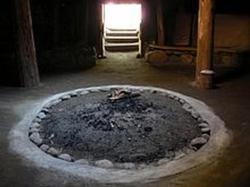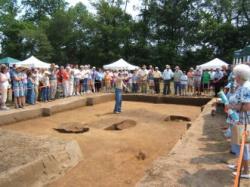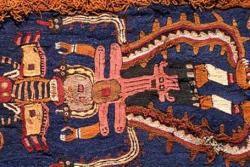INSTITUT SUPERIEUR D'ANTHROPOLOGIE
INSTITUTE OF ANTHROPOLOGY
ONLINE COURSES / COURS A DISTANCE
SUMMER TERM : JULY 2014
REGISTER NOW
PEROU –  Punta de Bombon - Archaeologists working in the Tambo Valley in the southern region of Arequipa recently discovered a tomb built by members of the Tiahuanaco culture. El Comercio reports that a team of archaeologists from Wroclaw University and Poland and the Universidad Católica de Santa Maria in Arequipa found the tomb near the town of Punta de Bombon. Though the tomb had apparently been looted by antiquities traders, investigators were able to recover human remains as well as several other significant artifacts. According to El Comercio, two artifacts found by the team are especially important for archaeologists’ understanding of the Tiahuanaco people: a funerary bundle and a ceramic ceremonial offering. The archaeologists worked on the excavation from March until May. In addition to the Tiahuanaco tombs, they discovered graves from cultures that inhabited the area in later years. Because the Tiahuanaco are not known to have widely expanded this close to the coast, the investigators are saying the tombs are an isolated case instead of evidence of a previously-unknown settlement. The Tiahuanaco people lived in southern Peru and Bolivia and are best known for the Tiahuanaco city archaeological site in Bolivia. El Comercio reports that the tombs found in Arequipa were likely constructed between 600 AD and 800 AD.
Punta de Bombon - Archaeologists working in the Tambo Valley in the southern region of Arequipa recently discovered a tomb built by members of the Tiahuanaco culture. El Comercio reports that a team of archaeologists from Wroclaw University and Poland and the Universidad Católica de Santa Maria in Arequipa found the tomb near the town of Punta de Bombon. Though the tomb had apparently been looted by antiquities traders, investigators were able to recover human remains as well as several other significant artifacts. According to El Comercio, two artifacts found by the team are especially important for archaeologists’ understanding of the Tiahuanaco people: a funerary bundle and a ceramic ceremonial offering. The archaeologists worked on the excavation from March until May. In addition to the Tiahuanaco tombs, they discovered graves from cultures that inhabited the area in later years. Because the Tiahuanaco are not known to have widely expanded this close to the coast, the investigators are saying the tombs are an isolated case instead of evidence of a previously-unknown settlement. The Tiahuanaco people lived in southern Peru and Bolivia and are best known for the Tiahuanaco city archaeological site in Bolivia. El Comercio reports that the tombs found in Arequipa were likely constructed between 600 AD and 800 AD.
http://www.peruthisweek.com/news-archaeologists-discover-tiahuanaco-tomb-in-southern-peru-103256
CANADA –  Slocan Narrows - Although many people might not find archaeology as exciting as it’s portrayed in the Indiana Jones franchise, Morgan Biggs ‘16 does. Biggs, an archaeology major, is working with Assistant Professor of Archaeology Nathan Goodale to analyze artifacts from the Slocan Narrows Archaeological Project (SNAP). Last summer, Biggs attended Hamilton’s field school, led by Goodale, and excavated artifacts from the Slocan Narrows Pithouse Village in southeastern British Columbia, Canada. The village, which was occupied 2,700 years ago, is home to one of the largest pit houses in the Pacific Northwest. The SNAP team excavated these pithouses, a type of group dwelling that is partially underground, and found flakes from stone tools. The group recorded the precise location of each flake, postulating as to whether the tools were made on-site or were simply sharpened there. After gathering artifacts, the team used an x-ray fluorescence spectrometer to determine the elemental composition and origins of the items. This is an important step, as Biggs pointed out, because it can be used to understand migration patterns and trade routes of ancient populations. This summer, Biggs is working on the Hill, doing lithic analysis of the stone fragments. Meticulously pouring over each flake, Biggs determines precisely how each piece was created. Using Sullivan and Rozen Typology, Biggs then scrutinizes the unique size and shape of the artifact, taking extensive notes to help categorize them. Eventually, Biggs will use her compiled data to write a chapter in the official report to the Canadian government.
Slocan Narrows - Although many people might not find archaeology as exciting as it’s portrayed in the Indiana Jones franchise, Morgan Biggs ‘16 does. Biggs, an archaeology major, is working with Assistant Professor of Archaeology Nathan Goodale to analyze artifacts from the Slocan Narrows Archaeological Project (SNAP). Last summer, Biggs attended Hamilton’s field school, led by Goodale, and excavated artifacts from the Slocan Narrows Pithouse Village in southeastern British Columbia, Canada. The village, which was occupied 2,700 years ago, is home to one of the largest pit houses in the Pacific Northwest. The SNAP team excavated these pithouses, a type of group dwelling that is partially underground, and found flakes from stone tools. The group recorded the precise location of each flake, postulating as to whether the tools were made on-site or were simply sharpened there. After gathering artifacts, the team used an x-ray fluorescence spectrometer to determine the elemental composition and origins of the items. This is an important step, as Biggs pointed out, because it can be used to understand migration patterns and trade routes of ancient populations. This summer, Biggs is working on the Hill, doing lithic analysis of the stone fragments. Meticulously pouring over each flake, Biggs determines precisely how each piece was created. Using Sullivan and Rozen Typology, Biggs then scrutinizes the unique size and shape of the artifact, taking extensive notes to help categorize them. Eventually, Biggs will use her compiled data to write a chapter in the official report to the Canadian government.
http://www.hamilton.edu/news/story/piecing-together-the-past-artifacts-from-2-700-year-old-village
USA – Plymouth - Those may look like open graves on the east side of Burial Hill. But what you’re seeing as you drive along School Street in downtown Plymouth is actually an archaeological dig in process.Researchers are purposefully steering clear, at least for now, of any known burial locations. The fresh excavations are in areas that previous research indicates do not include burial sites or other previously studied artifacts.The Center is making extensive use of ground positioning radar (GPR) to further identify what may lie underground and also test the effectiveness of GPR on the soil found in our area. Crudely put, if you understand the soil conditions, the radar data can be interpreted more accurately, helping you to determine where and how deeply artifacts are located.
http://plymouth.wickedlocal.com/article/20140617/NEWS/140617806
ROYAUME UNI –  Lundy Island -A dive trail has opened on the protected wreck of the 19th century paddle steamer Iona II off Lundy Island, near the Bristol Channel. The iron-hulled ship was lost while seeking shelter from a storm off Lundy in January 1864, having been built on the Clyde only the year before. The ship was intended as a local excursion and mail boat operating between Glasgow and the Western Isles. However, shortly after commissioning, it was purchased for use as a Confederate blockade runner in the American Civil War. It sank after setting out from Ireland, bound for Madeira on the first leg of its trans-Atlantic delivery voyage. The wreck was found in 1976 and designated as a protected site in 1990.
Lundy Island -A dive trail has opened on the protected wreck of the 19th century paddle steamer Iona II off Lundy Island, near the Bristol Channel. The iron-hulled ship was lost while seeking shelter from a storm off Lundy in January 1864, having been built on the Clyde only the year before. The ship was intended as a local excursion and mail boat operating between Glasgow and the Western Isles. However, shortly after commissioning, it was purchased for use as a Confederate blockade runner in the American Civil War. It sank after setting out from Ireland, bound for Madeira on the first leg of its trans-Atlantic delivery voyage. The wreck was found in 1976 and designated as a protected site in 1990.
http://www.sportdiver.co.uk/News/Latest-News/Iona-II-dive-trail-now-open
IRLANDE – Achill Site - A group of international archaeologists and students are attempting to uncover the origins of a prehistoric site on Achill Island which has perplexed and divided opinion among archaeologists for over 100 years. The team of archaeologists and students from the Achill Field School are currently excavating a Bronze Age site at the base of Slievemore on Achill which was first examined over 100 years and still divides opinions of what it was among the archeology world. Stuart Rathborne, the Director of Fieldwork at the Achill Field School told The Mayo News that the site is located 100 metres west of the Megalithic Tombs and described it as a ‘bit of a mystery’. “No one really knows what it is. People have been looking at it for over 100 years and this year we took the decision to have a proper look and see what it is. It looks similar to a lot of things but not exactly like anything else. There is a lot of stone poking out of the bog... maybe it is a tomb or may be some sort of home site or some sort of kiln. It is just a really curious site,” he explained. “The first person to look at it was WG Woodmartin from Sligo in 1888 and he wrote about the site. Ever since archaeologists have tried to get answers as to what it is. Some of the biggest names in Irish archaeology have looked at it but cannot agree on what it is. It appears to be a bit of a mystery but hopefully by the end of the summer we might know.” The Achill Field School has been conducting archaeological excavations at the base of Slievemore every summer since it was founded in 1991 as a training school for students. This year students from North America are taking part in the dig which will continue until the end of August and may recommence next summer. Stuart’s own theory of what the site might be is that of a tomb converted into a home but said that normally finds like this are the ‘other way around’ and was ‘a big guess at the moment’. He said they hoped to have some answers at the end of the summer. One of the reasons the site is such a mystery is due to its size which Stuart says is a lot bigger than other sites of the same era. However, he has worked as Director of Fieldwork since 2008 and not surprised by what they discover in sites around Slievemore. “They [students] will not see anything like the excavations of the bogs of Mayo which turn up all sorts of odd things. Up Slievemore the Bronze Age houses are much bigger than anywhere else and the kiln’s happen to be bigger there. There is always something strange around here,” he said.
http://www.mayonews.ie/index.php?option=com_content&view=article&id=20121:archeologists-begin-dig-on-mysterious-achill-site&catid=23:news&Itemid=46
USA –  Morganton -The Berry Site marks the remains of Fort San Juan, one of six fortifications built during Juan Pardo’s 1566 Spanish expedition into the inland of America. The fort was built on the native settlement of Joara, a Mississippian culture center believed to have been home to the ancestral Catawba. The 1566 expedition was decades before the establishment of Jamestown and the Lost Colony of Roanoke, making Fort San Juan the oldest known European settlement in the American interior.“It’s the earliest interior fort in what is now the United States. It is significant because it [represents] the most in-depth effort to colonize the United States. [The Spanish] were looking for gold and silver and many don’t realize that had they found that gold here, there’s no doubt that they would have sent waves of armies … making this area still under Spanish control right up until today — it would have changed the true course of history.”The expedition ended entirely once Fort San Juan and the other Spanish forts were destroyed by natives in 1568.
Morganton -The Berry Site marks the remains of Fort San Juan, one of six fortifications built during Juan Pardo’s 1566 Spanish expedition into the inland of America. The fort was built on the native settlement of Joara, a Mississippian culture center believed to have been home to the ancestral Catawba. The 1566 expedition was decades before the establishment of Jamestown and the Lost Colony of Roanoke, making Fort San Juan the oldest known European settlement in the American interior.“It’s the earliest interior fort in what is now the United States. It is significant because it [represents] the most in-depth effort to colonize the United States. [The Spanish] were looking for gold and silver and many don’t realize that had they found that gold here, there’s no doubt that they would have sent waves of armies … making this area still under Spanish control right up until today — it would have changed the true course of history.”The expedition ended entirely once Fort San Juan and the other Spanish forts were destroyed by natives in 1568.
http://www.hcpress.com/upcoming-events/fort-san-juan.html
USA – Nauvoo - An archaeological dig is underway in a tiny western Illinois community for the possible location of a home built for the one-time patriarch of the Church of Jesus Christ of Latter-day Saints. Searchers for the one-time dwelling of Joseph Smith Sr. and wife Lucy Mack — parents of Joseph Smith, the founder of the Mormon church — have uncovered what appears to be a structural support for the house that research indicates was a double log cabin, the Quincy Herald-Whig (http://bit.ly/U2eGAa ) reported. They've also found a small house key, along with thousands of bits of pottery, window glass, metal and buttons. Those discoveries by volunteers over the past three years suggest that the site being sought is just south of the historic Joseph and Emma Smith Mansion House in 1,100-resident Nauvoo (nah-VOO') in Hancock County.
http://www.enquirerherald.com/2014/06/16/3073099/archaeologists-seek-site-of-mormon.html?sp=/99/117/365/
PEROU – Paracas - A pre-Incan funeral shroud is being displayed in Peru after a Swedish museum returned the ancient artifact to the South American nation. The Shroud of Gothenburg, which is composed of 32 woven frames and features some 80 hues of blue, green, yellow and red, was smuggled out of Peru by a Swedish diplomat in 1934. It's one of 89 textiles being returned to Peru by 2021 as part of an international agreement between the two countries.Aside from a remarkable display of color and intricacy, the garments depict condors, frogs, cats, corn, cassava and people. Researchers believe the imagery and design served as some sort of farming calendar. The rest of the shrouds and other textiles are currently being cared for by Sweden's Museum of World Culture. The first returned shroud -- now displayed in National Museum of Archaeology, Anthropology and History in Lima, Peru's capital -- is one of four shrouds discovered on the Paracas Peninsula in the 1920s. They are the product of of the Paracas civilization, an ancient people about whom archaeologists and historians know very little. Although most evidence of the civilization is concentrated in Peru's Paracas Peninsula, its believed the people were part of an ancient Andean civilization that once stretched along the Pacific coast. The funeral shrouds are estimated to be more than 2,000 years old, but as the Museum of World Culture explained, they are in remarkable condition, "as the the textiles were naturally preserved in the salty sands of the Paracas."
Paracas - A pre-Incan funeral shroud is being displayed in Peru after a Swedish museum returned the ancient artifact to the South American nation. The Shroud of Gothenburg, which is composed of 32 woven frames and features some 80 hues of blue, green, yellow and red, was smuggled out of Peru by a Swedish diplomat in 1934. It's one of 89 textiles being returned to Peru by 2021 as part of an international agreement between the two countries.Aside from a remarkable display of color and intricacy, the garments depict condors, frogs, cats, corn, cassava and people. Researchers believe the imagery and design served as some sort of farming calendar. The rest of the shrouds and other textiles are currently being cared for by Sweden's Museum of World Culture. The first returned shroud -- now displayed in National Museum of Archaeology, Anthropology and History in Lima, Peru's capital -- is one of four shrouds discovered on the Paracas Peninsula in the 1920s. They are the product of of the Paracas civilization, an ancient people about whom archaeologists and historians know very little. Although most evidence of the civilization is concentrated in Peru's Paracas Peninsula, its believed the people were part of an ancient Andean civilization that once stretched along the Pacific coast. The funeral shrouds are estimated to be more than 2,000 years old, but as the Museum of World Culture explained, they are in remarkable condition, "as the the textiles were naturally preserved in the salty sands of the Paracas."
http://www.upi.com/Top_News/World-News/2014/06/17/Peru-displays-pre-Incan-funeral-shroud/5681403015679/?